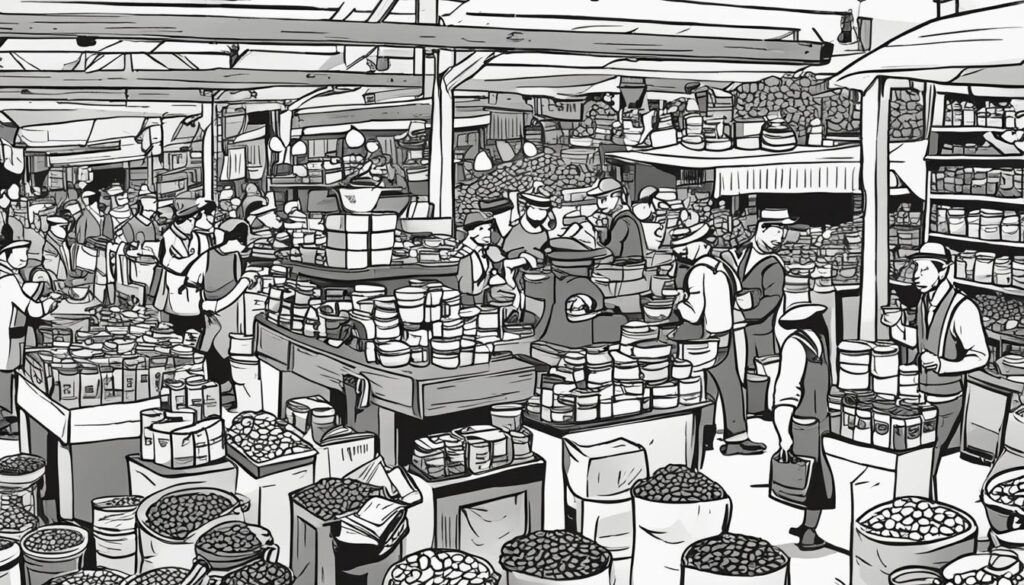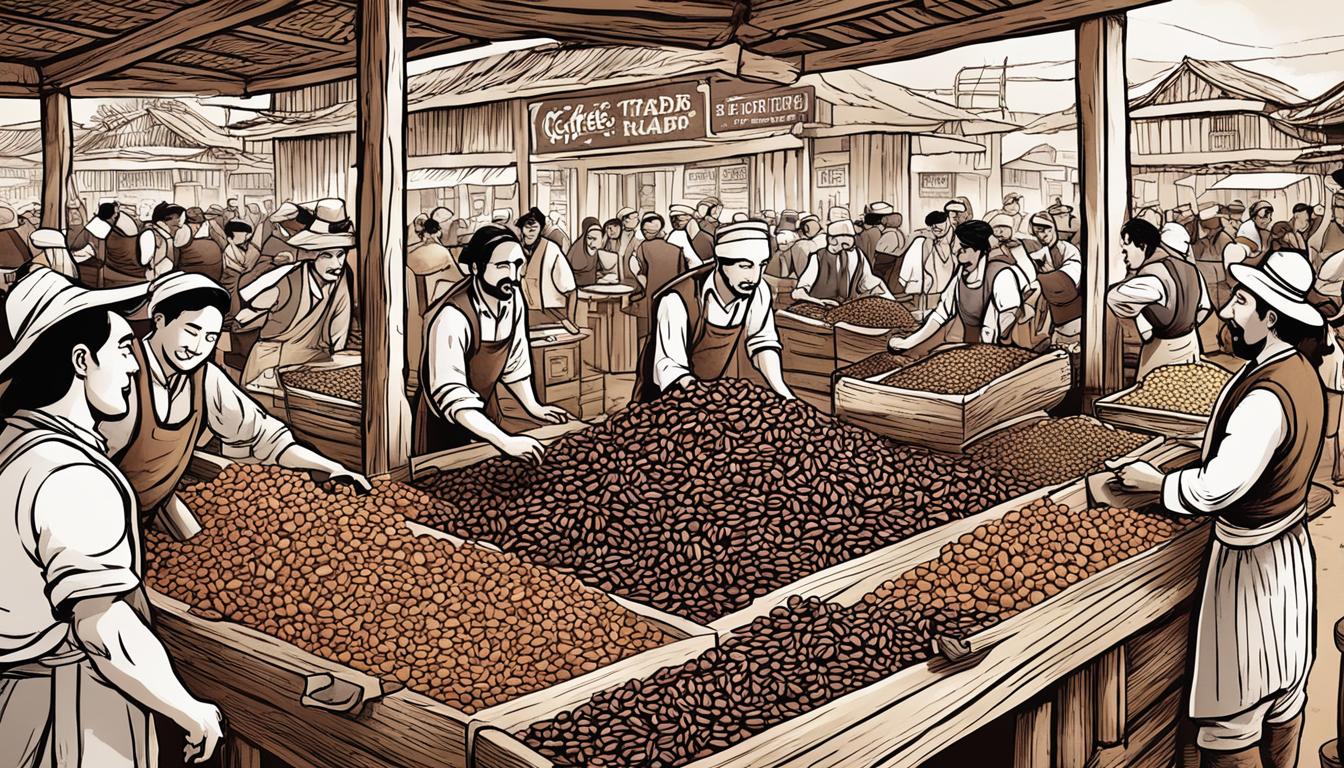In this article, we will provide a book summary of The Coffee Trader by David Liss, a captivating novel set in 17th-century Amsterdam. The story follows an ambitious trader’s pursuit of wealth and success amidst the complex webs of commerce, intrigue, and betrayal.
Read on to explore the historical setting of 17th-century Amsterdam and learn more about the main characters and themes that drive this enthralling story.
Key Takeaways
- The Coffee Trader by David Liss is a captivating historical fiction novel set in 17th-century Amsterdam.
- The novel explores the complex dynamics of trade, commerce, intrigue, and betrayal, providing an enthralling narrative.
- The story follows the ambitious trader’s pursuit of wealth and success and sheds light on the societal issues of the time.
- The book has received critical acclaim and made a lasting impact on the genre of historical fiction.
- Readers who enjoy stories of ambition, deception, and historical fiction will find The Coffee Trader a must-read.
Historical Setting of 17th-Century Amsterdam
David Liss’s The Coffee Trader takes place in 17th-century Amsterdam, a bustling city that served as a hub of trade and commerce. Known as the “Golden Age” of Dutch history, this period saw the rise of Amsterdam as a global economic power, with merchants and traders flocking to the city in search of profits.
The city’s strategic location on the North Sea and the River Amstel made it an ideal center for trade, facilitating the exchange of goods and ideas between different regions. Amsterdam’s bustling ports and markets were filled with a variety of merchants, from spice traders to diamond merchants, creating a vibrant and diverse economic landscape.
Despite its economic prosperity, the city was not without its challenges. Social and political tensions simmered beneath the surface, as the ruling class and common people jockeyed for power and influence. Religious conflict also played a role, with the Protestant Dutch Republic facing off against the Catholic Habsburg Empire.
Against this backdrop of commerce and conflict, The Coffee Trader unfolds, offering readers a glimpse into the complex tapestry of life in 17th-century Amsterdam.
Introduction to The Coffee Trader
David Liss’s The Coffee Trader takes readers on a thrilling journey through 17th-century Amsterdam, a time when trade and commerce were booming, and the stakes were high. The story centers around Miguel Lienzo, a former merchant seeking to rebuild his fortune by becoming a trader of a new commodity – coffee. As Miguel navigates the competitive world of trade, he finds himself caught up in a web of deceit and betrayal, where nothing is as it seems.
The Coffee Trader’s main characters are richly drawn, each with their own motivations and secrets. Alongside Miguel, readers will meet the charming and cunning Geertruid Damhouder, the mysterious and conflicted Sophia van Loon, and the ruthless and dangerous Jeronimus Cornelisz.
Liss weaves together multiple themes throughout the book, including the dangers of ambition, the complexity of relationships, and the societal implications of commerce. These themes explore the darker side of human nature and shed light on the complexities of family ties, romantic relationships, and business dealings in a rapidly changing world.
Join us as we dive deeper into the world of The Coffee Trader and explore the characters, themes, and narrative style that make this book a must-read.
Main Characters in The Coffee Trader
In this section, we will explore the main characters in The Coffee Trader and their pivotal roles in the development of the story.
Miguel Lienzo
The ambitious protagonist of The Coffee Trader, Miguel Lienzo, is a former diamond merchant trying to rebuild his fortune through the coffee trade. Driven by his desire for success and a need to prove himself to Amsterdam’s business elite, Lienzo is willing to take risks and make questionable alliances to achieve his goals.
Geertruid Damhouder
The widow of a wealthy trader, Geertruid Damhouder, is one of Lienzo’s primary competitors and allies. With her knowledge of the market and her connections within Amsterdam’s upper echelon, Damhouder becomes a key player in Lienzo’s journey towards success, even as she struggles with her own conflicting feelings towards him.
Paulus Melk
The enigmatic Paulus Melk is one of Lienzo’s closest confidants in the world of Amsterdam’s coffee trade. An expert in the art of negotiation and bartering, Melk becomes instrumental in Lienzo’s rise to success, even as his ulterior motives and shadowy past begin to come to light.
Cornelius Van Streech
Cornelius Van Streech, a respected member of Amsterdam’s high society, is one of Lienzo’s most formidable opponents. Van Streech uses his influence and wealth to undermine Lienzo’s coffee business, ultimately leading to a dangerous game of deceit and betrayal between the two men.
Benjamin Jacob Israel
Benjamin Jacob Israel, a Jewish diamond merchant, becomes an unlikely ally to Lienzo in his quest for success. Though their backgrounds and beliefs differ, the two men form a profitable partnership that threatens to upset the established power dynamics of Amsterdam’s coffee trade.
Themes Explored in The Coffee Trader
The Coffee Trader explores a variety of themes that offer insight into both individual and societal issues. At its core, the book delves into the dynamics of 17th-century trade, showcasing the power struggles and complexities of commerce during this time period. Through the intertwining stories of the main characters, however, the narrative also delves into broader themes of ambition and betrayal.
One prominent theme in The Coffee Trader is the role of women in society. Liss offers a nuanced portrayal of female characters in the novel, showing how they must navigate a male-dominated world to pursue their ambitions. For example, we see how protagonist Miguel Lienzo’s sister-in-law, Geertruid Damhouder, uses her intelligence and resourcefulness to gain access to the world of trade and finance.
Another key theme in The Coffee Trader is the nature of loyalty and betrayal. Throughout the novel, characters grapple with the question of who they can trust, highlighting the fragile nature of relationships in a world rife with conflict and competition. This theme comes to a head in the book’s climactic scene, where allegiances are tested and secrets revealed.
Economic Power Struggles
The book’s focus on trade and commerce also opens up broader discussions of the economic power struggles that were prevalent in 17th-century Amsterdam. We learn how coffee, once considered a luxury item, becomes a coveted commodity among traders looking to secure their financial futures. This shift catalyzes the primary plot points of the story as Miguel Lienzo seeks to overturn the established coffee traders and make a name for himself in the market.

Overall, The Coffee Trader is a complex and compelling novel that offers rich insights into the social and economic forces at play in 17th-century Amsterdam. By weaving together themes of trade, ambition, and betrayal, David Liss crafts a story that is simultaneously thrilling and thought-provoking.
Plot Summary of The Coffee Trader
In The Coffee Trader, readers follow the journey of Miguel Lienzo, a former trader trying to regain his wealth and status in 17th-century Amsterdam. Miguel recognizes the potential for a new market in coffee and teams up with fellow trader Geertruid Damhouder to take advantage of it. However, their plans are complicated by betrayal, ambition, and the shifting alliances of the city’s powerful guilds.
As Miguel navigates this dangerous world, he becomes increasingly entangled with characters such as Sophien, a beautiful courtesan with a hidden agenda, and Daniel Waterland, an enigmatic figure with a dark past. As The Coffee Trader unfolds, readers are drawn into a web of intrigue and deception that culminates in a shocking climax.
The Beginning
The novel begins with Miguel’s return to Amsterdam after a failed trading venture in India. Desperate to regain his wealth and status, he teams up with Geertruid, an intelligent and ambitious woman, to enter the world of coffee trading. Their plans are initially successful, and Miguel begins to climb the ranks of the city’s powerful guilds.
Twists and Turns
The plot takes a series of unexpected turns as Miguel and Geertruid’s partnership falls apart and they each pursue their individual goals. Alongside this, Miguel becomes increasingly wrapped up in the machinations of Sophien and Daniel Waterland, both of whom have their own motivations and secrets.
| Key Moments | Character Developments |
|---|---|
| – Miguel and Geertruid’s successful coffee trading venture | – Miguel’s transformation from a cautious former trader to a bold and ambitious businessman |
| – The decline of Miguel and Geertruid’s partnership | – Geertruid’s increasing ambition and willingness to betray others to achieve her goals |
| – The revelation of Sophien’s true identity and intentions | – Sophien’s growth from a seemingly one-dimensional courtesan to a complex and sympathetic character |
| – The consequences of Daniel Waterland’s past actions on the present | – Daniel’s redemption after a lifetime of deception and guilt |
The Climax
The Coffee Trader reaches its climax as Miguel’s past and present collide, and he is forced to contend with the consequences of his actions and the deception of those around him. The novel ends on a note of uncertainty and possibility, leaving readers to contemplate the complex moral landscape of 17th-century Amsterdam.
Writing Style and Narrative Techniques
In The Coffee Trader, David Liss employs various writing styles and narrative techniques that make the story even more engaging. One of his techniques is the use of sensory details that give readers a vivid experience of 17th-century Amsterdam. Through descriptive language, Liss captures the sights, smells, and sounds of the bustling cityscape, immersing readers in its historical setting.
Liss also uses alternating points of view to show different perspectives of the story. This technique allows readers to understand the characters’ motivations and internal conflicts, adding depth to their portrayals.
Another noteworthy technique used in The Coffee Trader is the incorporation of real historical events and figures. Liss weaves these elements seamlessly into his narrative, creating a sense of realism and authenticity that readers appreciate.
Overall, Liss’s writing style and narrative techniques make The Coffee Trader a compelling and immersive historical fiction read.
Critical Reception and Impact of The Coffee Trader
Since its publication in 2003, The Coffee Trader has garnered critical praise and left a lasting impact on the genre of historical fiction.
Critics have lauded David Liss’s ability to transport readers back to 17th-century Amsterdam, immersing them in a world of commercial ambition and political intrigue. The New York Times Book Review praised Liss’s “skillful storytelling” and called The Coffee Trader “an absorbing novel.” Similarly, Publishers Weekly deemed it a “vividly detailed, boisterous page-turner” that “skewers religious fundamentalism and government corruption with equal fervor.”
The book’s impact can be seen in the numerous accolades it has received, including the 2004 Edgar Award for Best Novel and the 2003 Macavity Award for Best Historical Mystery. Additionally, The Coffee Trader has been translated into multiple languages and continues to captivate readers around the world.
Conclusion
In conclusion, The Coffee Trader by David Liss is a captivating novel that offers readers an immersive glimpse into the world of 17th-century trade. Through its intricate plot and well-crafted characters, Liss skillfully weaves together themes of commerce, intrigue, and betrayal to create a gripping narrative.
Readers will be drawn into the bustling city of Amsterdam and the challenges faced by the protagonist, Miguel Lienzo, as he navigates the high-stakes world of coffee trading. Along the way, they will encounter a cast of memorable characters, each with their own motivations and secrets.
Furthermore, Liss’s writing style and narrative techniques add to the immersive experience, transporting readers back in time with vivid descriptions and a compelling storyline. The book’s critical reception and lasting impact on the historical fiction genre attest to its enduring appeal and relevance.
Whether you are a fan of the genre or simply looking for a captivating read, The Coffee Trader is a must-add to any bookshelf.



